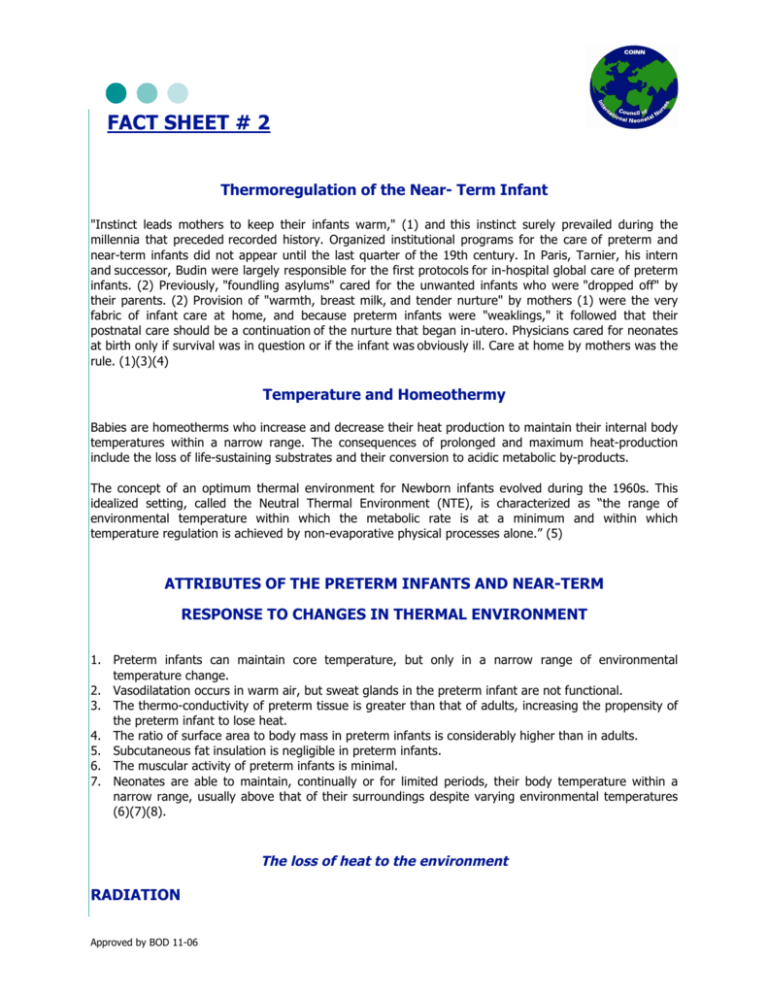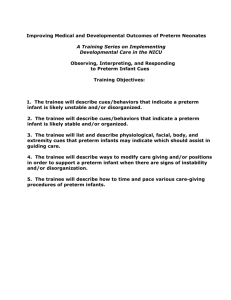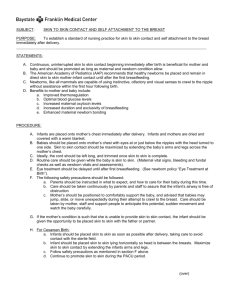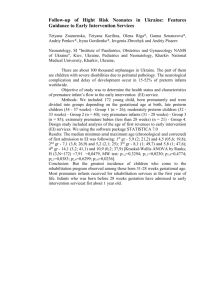fact sheet # 2 - Unifying Neonatal Nurses Globally
advertisement

FACT SHEET # 2 Thermoregulation of the Near- Term Infant "Instinct leads mothers to keep their infants warm," (1) and this instinct surely prevailed during the millennia that preceded recorded history. Organized institutional programs for the care of preterm and near-term infants did not appear until the last quarter of the 19th century. In Paris, Tarnier, his intern and successor, Budin were largely responsible for the first protocols for in-hospital global care of preterm infants. (2) Previously, "foundling asylums" cared for the unwanted infants who were "dropped off" by their parents. (2) Provision of "warmth, breast milk, and tender nurture" by mothers (1) were the very fabric of infant care at home, and because preterm infants were "weaklings," it followed that their postnatal care should be a continuation of the nurture that began in-utero. Physicians cared for neonates at birth only if survival was in question or if the infant was obviously ill. Care at home by mothers was the rule. (1)(3)(4) Temperature and Homeothermy Babies are homeotherms who increase and decrease their heat production to maintain their internal body temperatures within a narrow range. The consequences of prolonged and maximum heat-production include the loss of life-sustaining substrates and their conversion to acidic metabolic by-products. The concept of an optimum thermal environment for Newborn infants evolved during the 1960s. This idealized setting, called the Neutral Thermal Environment (NTE), is characterized as “the range of environmental temperature within which the metabolic rate is at a minimum and within which temperature regulation is achieved by non-evaporative physical processes alone.” (5) ATTRIBUTES OF THE PRETERM INFANTS AND NEAR-TERM RESPONSE TO CHANGES IN THERMAL ENVIRONMENT 1. Preterm infants can maintain core temperature, but only in a narrow range of environmental temperature change. 2. Vasodilatation occurs in warm air, but sweat glands in the preterm infant are not functional. 3. The thermo-conductivity of preterm tissue is greater than that of adults, increasing the propensity of the preterm infant to lose heat. 4. The ratio of surface area to body mass in preterm infants is considerably higher than in adults. 5. Subcutaneous fat insulation is negligible in preterm infants. 6. The muscular activity of preterm infants is minimal. 7. Neonates are able to maintain, continually or for limited periods, their body temperature within a narrow range, usually above that of their surroundings despite varying environmental temperatures (6)(7)(8). The loss of heat to the environment RADIATION Approved by BOD 11-06 Radiant heat loss is described as the net rate of heat loss in the form of electromagnetic waves between the body and surfaces not in contact with the body, for example the walls of an incubator or a nearby glass window. This type of heat loss depends on a number of factors, including the temperature of the skin, the relative surface area of the infant and the distance to the incubator walls or window. (9) EVAPORATION This is defined as the total heat transfer by energy carrying water molecules from the infant’s skin and exhaled respiration’s to a drier environment. Preterm infant’s skin (immature stratum corneum) differs to that of a term infant for the first 2 weeks of life and therefore he or she is more prone to this type of heat loss. (9) CONVECTION Convection is the transfer of thermal energy from the molecules of the body to the molecules of an adjacent gas. Heated gas expands (Boyle’s law) and is displaced upwards by the force of gravity of the cooler and denser surrounding gas. This gas movement is called free convection. An example of this would be cooler air currents within a nursery. (9) CONDUCTION Conduction is the transfer of energy from the molecules of a body to the molecules of a solid object in contact with that body. An example of this would be the infant lying on a cold mattress. This type of heat loss is regarded as minimal as approximately only 10% of the infant’s body surface area is in contact with the mattress. (9) The Warm Chain 1. 2. 3. 4. 5. 6. 7. 8. 9. 10. Warm birthing room Immediate drying of infant Skin to skin contact with mother Breastfeeding Bathing and weighing postponed Appropriate clothing and bedding Mother and baby together Warm transportation Warm resuscitation Education, training and raising awareness The “warm chain” is a set of interlinked procedures to be undertaken at birth and during the next few hours and days to minimise heat loss in all newborns. Failure to implement any one of these procedures will break the chain and put the newborn baby at risk of becoming cold. (10) Methods for warming and maintaining a Neutral Thermal Environment When making decisions regarding thermoregulation, it is important to consider resources required to maintain equipment and monitor for potential changes in infection colonization patterns. Kangaroo Mother Care (Skin to Skin) Approved by BOD 11-06 Kangaroo-mother care is a non-conventional method for caring for low birth weight and preterm newborns after initial stabilization. The primary features of kangaroo-mother care are uninterrupted use of adult body heat (skin-to-skin contact) in order to maintain the newborn's body temperature and exclusive breast-feeding. The newborn is placed in a prone and upright (or diagonal) position between the mother's breasts, and covered with the mother's clothes and a cloth/blanket/shawl, for most of the day and night. Kangaroomother care is suitable for low birth weight newborns with no medical problems or after they have been corrected and when clinical signs are stable. Apart from being an efficient way of keeping the newborn baby warm, kangaroo-mother care promotes breast-feeding, physical growth and extra-uterine adaptation, and increases the mother's confidence, ability and involvement in the care of her small newborn. (10) AIR HEATED INCUBATORS Air-heated incubators are widely used for the care of very small and/or sick newborns. They provide a clean, warm environment, where the temperature and humidity can be controlled and oxygen can be supplied if necessary. Incubators also allow easy observation of the naked infant if necessary, and isolation. Incubators have numerous advantages but they are expensive to buy and the running costs are high. Another potential issue is that air heated incubators may create an extra physical barrier between mother and baby. Furthermore, if they are not used and maintained correctly, they may be more of a hazard than a benefit to the newborn. (10) RADIANT HEATERS Radiant heaters are overhead heating elements that provide warmth locally. The advantage of using this form of heating is that it allows for direct observation and free access to the baby. Radiant heaters can be used to produce a limited area of warmth where sick and low birth weight newborns can be rewarmed, given oxygen if needed and observed naked. A 400-watt radiant warmer placed 50 cm above the baby will be sufficient. This method is effective only if the room temperature is kept high (above 25°C/77°F). Spot lights or bulbs are dangerous because they focus the heat and may burn the baby. However radiant heaters have several disadvantages. If a baby is left for a prolonged period under a radiant heater it risks becoming dehydrated if enough fluids are not given, especially if it is very premature. If the temperature of the radiant heater is not monitored adequately, there is also a risk of overheating or first degree burns. There should never be more than one baby under one lamp because of the risk of cross infection and of unequal heat distribution causing some babies to be too warm and others not warm enough. Thus radiant heaters should only be used for short periods - for example, in the delivery room, for resuscitation or during procedures in intensive care units. This method of heating should be replaced by other alternatives as soon as possible. (10) Environmental temperature (warm rooms) The "warm room" (also called space heated room) is one that is set apart and kept sufficiently heated to meet the needs of hypothermic newborns, preterm and sick babies, but it may also be a blocked-off portion of a larger room. The room or area can be kept warm by electrical or solar heaters. It is important to keep the babies clothed. Approved by BOD 11-06 Experience has shown that warm rooms are effective at maintaining the body temperature of low birth weight babies. The lower the birth weight of the baby and the more premature, the higher the temperature of the room should be. For example, the appropriate room temperature for a clothed newborn weighing 1-1.5 kg at birth is 30-33°C (86-91.4°F), for those weighing 1.5-2 kg it is 28-30°C (82.4-86°F), and for those weighing 2.0-2.5 kg it is 26-28°C (78.8-82.4°C). The room temperature required by the baby will gradually decrease over the first days of life. A baby with asphyxia, respiratory distress or sepsis needs a higher room temperature than a baby of the same weight without these problems. (10) HEATING/WARMING PADS The heated water-filled mattress is a safe device for keeping low birth weight/sick babies warm and is more economical than an incubator. The mattress is placed in an ordinary cot and filled with five litres of water. An electric heating plate and control unit fit into a compartment in the bottom of the mattress and keep the temperature of the water at 35-38°C (95-100.4°F). The baby is kept clothed and covered with a blanket in the cot. A reliable electricity supply is needed for this method. However, the mattress will maintain a constant temperature for several hours if the electricity does fail. The device does not create as much of a barrier between the mother and baby as an incubator. (10) PLASTIC WRAPS AND COVERINGS Recent studies have encouraged the introduction of polyethylene bags and wraps for use with babies born at approximately 30 weeks’ gestation or less. This type of warming is ideal for a preterm infant (at birth and the immediate hours following) awaiting transportation to a tertiary care facility, or indeed a baby born in a tertiary care facility. The baby is placed on a warm towel (but not dried) and placed under a radiant warming heating device (or if unavailable, into an incubator). The baby (excluding his or her head) is placed fully in the polyethylene bag or wrapped in the polyethylene sheet. It is important that the baby remains under the radiant warmer (or in the incubator) as this heat acting through the covering and on the baby’s moist skin creates a warm thermal environment for the baby. Cutting an appropriately sized hole through the covering over the area of insertion can facilitate the introduction of any catheters or cannulae. (11) (12) (25) (26) HUMIDIFICATION AND TOPICAL OINTMENT Over the years there have been many studies and clinical trials that have demonstrated the importance and clinical application of both the uses of humidity and topical ointment therapy with preterm infants. The optimal humidity level for the Neonate is 50% relative humidity (RH). (13) This can be achieved by a variety of methods such as closed humidified incubators and humidity “tents”. It should be noted that extremely premature infants might require RH of up to 85% in the first 2 weeks of their lives. (14) (15) (16) (17) Topical ointment application (petroleum jelly base) has been advocated since the 1980’s. (18) (19) (23) (24) This involves the application of commercially available preparations to the extremely preterm infant’s unbroken skin on a regular basis after birth. This application reduces the effect of transepidermal water loss (TEWL) and acts as a “barrier” to the preterm infant’s skin assisting in thermal control. (18) (19) (20) (21) (22) Approved by BOD 11-06 Recent studies suggest that there may be an increase in the risk of nosocomial bacterial sepsis, associated to the application of topical ointment to infants below 30 weeks gestation and between birth weights of 501 to 1000g. (27) Information compiled by: Michael J McIlhone RN Clinical Nurse Educator Neonatal Service Christchurch Women’s Hospital New Zealand, November 2006 Michael.mcilhone@cdhb.govt.nz References: 1. Baker JP. Between fetus and weakling. In: Baker JP. The Machine in the Nursery: Incubator Technology and the Origins of Newborn Intensive Care. Baltimore, Md: The Johns Hopkins University Press;1996 2. Raju TNK. From infant hatcheries to intensive care: some highlights of the century of neonatal medicine. In: Fanaroff AA, Martin RJ, eds. Neonatal-Perinatal Medicine: Diseases of the Fetus and Infant. 7th ed. St. Louis, Mo: Mosby, Inc;2002 :2 –16 3. Baker JP. The incubator and the medical discovery of the premature infant. J Perinatol.2000; 5 :321 – 328 4. Korones SB. An encapsulated history of thermoregulation in the Neonate. NeoReviews vol. 5 No. 3 March 2004 5. LeBlanc MH. The physical environment. In: Fanaroff AA, Martin RJ, eds. Neonatal-Perinatal Medicine: Diseases of the Fetus and Infant. 7th ed. St. Louis, Mo: Mosby, Inc;2002 :2 –16 6. Day R, Curtis J, Kelly M. Respiratory metabolism in infancy and in childhood. XXVII. Regulation of body temperature of premature infants. Am J Dis Child.1943; 65 :376 –398 7. Brück K. Temperature regulation in newborn infant. Biol Neonat.1961; 3 :65 –119 8. Hill JR. The physics and physiology of the development of homoeothermy. In: Somatic Stability in the Newly Born. Boston, Mass: Little, Brown & Company;1961 :156 –169 9. Dollberg S, Hoath SB. Temperature regulation in Preterm Infants: role of the skin-environment interface. NeoReviews vol. 2 No. 12 December 2001 10. Maternal and Newborn Health/Safe Motherhood Unit. Thermal Protection of the Newborn: a practical guide. World Health Organisation WHO/RHT/MSM/97.2 11. Vohra S, Frent G, Campbell V, Abbott M & Whyte R. Effect of polyethylene occlusive skin wrapping on heat loss in very low birth weight infants at delivery: a randomised trial. J. Pediatrics 134, 547-51, 1999 12. Lenclen R, Mazraani M, Jugie M, Couderc S, Hoenn E, Carbajal R, Blanc P and Paupe A. Reducing heat loss in preterm infants at delivery with polyethylene bags. Arch. Pediatrics 9, 238-244, 2002 13. Guidelines for perinatal care American Academy of Paediatrics, page 278, 1988 14.Gaylord M. et al. Improved Fluid Management Utilising Humidified Incubators in ELBW Infants, Journal of Perinatology, 21: 438-443. 2001 15. Bouattoura D, Villon P and Farges G. Dynamic Programming Approach for Newborn’s Incubator Humidity Control, IEEE Transactions on Biomedical Engineering, Vol. 45 No.1 January 1998 16. Seguin J. Relative Humidity under Radiant Warmers: Influence of Humidifier and Ambient Relative Humidity. American Journal of Perinatology, Vol. 14, No.9 515 – 518. 1997 17. Marshall A. Humidifying the environment for the Premature Neonate, Journal of Neonatal Nursing, January: 32-36. 1997 18. Evans N.J. and Rutter N. Development of the Epidermis in the Newborn, Biology of the Neonate, 49; 74-80. 1986 19. Lane A.T. Development and Care of the Premature Infant’s Skin. Paediatric Dermatology, Vol. 4; No. 1 1-5. 1987 20. Siegfried E. Newborn Skin, NeoPREP: An Intensive review course of Neonatal/Perinatal Medicine, 215. 1997 Approved by BOD 11-06 21. Winslow E.H. Dispelling the Petroleum Jelly Myth, AJN, November vol 98, No.11 16RR. 1998 22. Nopper A.M., Horii K.A., et Al. Topical Ointment Therapy Benefits Premature Infants Journal of Paediatrics, 660. 1996 23. Rutter N. and Hull D. Reduction of Skin Water Loss in the Newborn Effect of Applying Topical Agents. Archives of Disease In Childhood 669-675. 1981 24. Lane A.T. & Drost G. Effects of Repeated Application of Emollient Cream to Premature Neonate’s Skin. Paediatrics 415. 1993 25. Vohra S, Roberts R, Zhang B, Janes M, and Schmidt B. Heat loss prevention in the delivery room: An RCT of polyethylene occlusive skin wrapping in very preterm infants. J. Pediatrics 145, 750-753, 2004 26. Cramer K, Wiebe N, Hartling L, Crumley E, and Vohra S. Heat loss prevention: a systematic review of occlusive skin wrap for premature infants. J of Perinatology 25, 763-769, 2005 27. Edwards W, Connor J, and Soll R. The effect of prophylactic ointment therapy on nosocomial sepsis rates and skin integrity in infants with birth weights of 501 to 1000g. Pediatrics 113, 1195-1203, 2004 Council of International Neonatal Nurses, Inc. (COINN) ™ Global Unity for Neonatal Nurses www.coinnurses.org Approved by BOD 11-06




